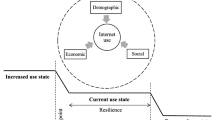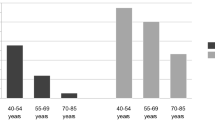Abstract
Access to the Internet is becoming increasingly important for all generations. However, a digital gap in Internet use remains between younger and older individuals as well as within the elderly population itself. This study, therefore, aimed to investigate Internet use among elderly Europeans. Representative data across 17 countries from the Survey of Health, Ageing and Retirement in Europe (SHARE) were examined. Analyses were based on the responses of 61,202 Europeans aged ≥ 50. Results highlight that, on average, 49% of all respondents use the Internet. However, the situation varies widely among European countries. Alongside individual indicators, such as age, gender, and social class, results indicate that previous experience with computers during one’s time in the workplace is positively associated with Internet use in old age. Furthermore, use of the Internet among an individual’s social network positively influences their use. Wider contextual structures such as area of residence and country-specific wealth and communication technology infrastructure also tend to promote Internet use among elderly Europeans. Data from SHARE indicate that private Internet use among older Europeans is driven by personal resources, prior experiences with technology, social salience as well as contextual influences.


Similar content being viewed by others
References
Hepp, A., Krotz, F.: Mediatized worlds: culture and society in a media age. Palgrave Macmillan, Basingstoke (2014)
Compaine, B.M.: The digital divide: facing a crisis or creating a myth?. MIT, Cambridge (2001)
Korupp, S.E., Szydlik, M.: Causes and trends of the digital divide. Eur. Sociol. Rev. 21, 409–422 (2005). https://doi.org/10.1093/esr/jci030
Czaja, S.J., Charness, N., Fisk, A.D., Hertzog, C., Nair, S.N., Rogers, W.A., et al.: Factors predicting the use of technology: findings from the Center for Research and Education on Aging and Technology Enhancement (CREATE). Psychol. Aging 21(2), 333–352 (2006). https://doi.org/10.1037/0882-7974.21.2.333
Lengsfeld, J.H.B.: An econometric analysis of the sociodemographic topology of the digital divide in Europe. Inf. Soc. 27, 141–157 (2011)
Brandtzæg, P.B., Heim, J., Karahasanović, A.: Understanding the new digital divide—a typology of internet users in Europe. Int. J. Hum. Comput. Stud. 69, 123–138 (2011). https://doi.org/10.1016/j.ijhcs.2010.11.004
Olson, K.E., O’Brien, M.A., Rogers, W.A., Charness, N.: Diffusion of technology: frequency of use for younger and older adults. Ageing Int 36, 123–145 (2011). https://doi.org/10.1007/s12126-010-9077-9
Seifert, A., Schelling, H.R.: Mobile use of the internet using smartphones or tablets by Swiss people over 65 years. Gerontechnology 14, 57–62 (2015). https://doi.org/10.4017/gt.2015.14.1.006.00
Doh, M., Schmidt, L.I., Herbolsheimer, F., Jokisch, M., Wahl, H.W.: Patterns of modern ICT use among “senior technology experts”: the role of demographic variables, subjective beliefs and attitudes. In: Zhou, J., Salvendy, G. (eds.) Human aspects of IT for the aged population. Design for aging. Springer, Los Angeles (2015). https://doi.org/10.1007/978-3-319-20892-3
Eurostat (2017) Individuals—internet use [isoc_ci_ifp_iu]. http://appsso.eurostat.ec.europa.eu/nui/show.do?dataset=isoc_ci_ifp_iu&lang=en. Accessed 16 May 2017
Seifert, A., Schelling, H.R.: Studie “Digitale Senioren”: Nutzung von Informations- und Kommunikationstechnologien (IKT) durch Menschen ab 65 Jahren in der Schweiz im Jahr 2015. Pro Senectute Schweiz, Zürich (2015)
Mingo, I., Bracciale, R.: The Matthew effect in the Italian digital context: the progressive marginalisation of the “poor”. Soc. Indic. Res. (2016). https://doi.org/10.1007/s11205-016-1511-2
Laslett, P.: The third age, the fourth age and the future. Ageing Soc. 14, 436–447 (1994). https://doi.org/10.1017/s0144686x00001677
Lawton, M.P.: Environment and other determinants of weil-being in older people. Gerontologist 23, 349–357 (1983). https://doi.org/10.1093/geront/23.4.349
Spellerberg, A.: Ländliche Räume in der hoch technisierten Dienstleistungsgesellschaft: mittendrin oder außen vor. In: Barlösius, E., Neu, C. (eds.) Peripherisierung—eine neue Form sozialer Ungleichheit?, pp. 25–35. Berlin-Brandenburgische Akademie der Wissenschaften, Berlin (2008)
Stenberg, P.L.: Communications and the internet in rural America. Agric Outlook 6, 23–26 (2002)
Warschauer, M.: Demystifying the digital divide. Sci. Am. 289, 42–47 (2003)
OECD (2017) Internet access (indicator). https://data.oecd.org/ict/internet-access.htm#indicator-chart. Accessed 01 Jul 2017
Sackmann, R., Winkler, O.: Technology generations revisited: the internet generation. Gerontechnology 11, 493–503 (2013). https://doi.org/10.4017/gt.2013.11.4.002.00
Rogers, E.M.: Diffusion of innovations, p. 551. Free Press, New York (2003)
Hüsing, T.: Zunehmendes Nord-Süd Gefälle der digitalen Spaltung in der EU: zur Messung von Ungleichheit in der Diffusion von Informations- und Kommunikationstechnologien. Informationsdienst Soziale Indikatoren 30, 1–5 (2003)
Friemel, T.N.: The digital divide has grown old: determinants of a digital divide among seniors. New Media Soc 18, 313–331 (2014). https://doi.org/10.1177/1461444814538648
Seifert, A., Doh, M., Wahl, H.-W.: They also do it: internet use by older adults living in residential care facilities. Educ. Gerontol. 9, 451–461 (2017). https://doi.org/10.1080/03601277.2017.1326224
Ching, C.C.: The legacy of the digital divide: gender, socioeconomic status, and early exposure as predictors of full-spectrum technology use among young adults. Urban Educ. 40, 394–411 (2005). https://doi.org/10.1177/0042085905276389
Helsper, E.J.: Gendered internet use across generations and life stages. Commun. Res. 37, 352–374 (2010). https://doi.org/10.1177/0093650209356439
Fernstrom, K., Ktoridou, D., Eteokleous-Grigoriou, N.: Developing digital immigrants’ computer literacy: the case of unemployed women. Campus Wide Inf. Syst. 28, 154–163 (2011). https://doi.org/10.1108/10650741111145689
Norris, P.: Digital divide: civic engagement, information poverty, and the Internet worldwide. Communication, society, and politics. Cambridge University Press, New York (2001)
Jung, Y., Peng, W., Moran, M., Jin, S.A., McLaughlin, M., Cody, M., Jordan-Marsh, M., Albright, J., Silverstein, M.: Low-income minority seniors’ enrollment in a cybercafé: psychological barriers to crossing the digital divide. Educ. Gerontol. 36, 193–212 (2010). https://doi.org/10.1080/03601270903183313
Bonfadelli, H.: The internet and knowledge gaps: a theoretical and empirical investigation. Eur. J. Commun. 17, 65–84 (2002)
Hargittai, E.: Digital Na(t)ives?: variation in internet skills and uses among members of the “net generation”. Sociol. Inq. 80, 92–113 (2010). https://doi.org/10.1111/j.1475-682x.2009.00317.x
Dobransky, K., Hargittai, E.: The disability divide in internet access and use. Inf. Commun. Soc. 9, 313–334 (2006)
Harrison, A.W., Rainer, R.K.: The influence of individual differences on skill in end-user computing. J. Manag, Inf. Syst. 9, 93–111 (2015). https://doi.org/10.1080/07421222.1992.11517949
van Deursen, A.: Internet skills and the digital divide. New Media Soc. 13, 893–911 (2011)
Venkatesh, V., Davis, F.D.: A theoretical extension of the technology acceptance model: four longitudinal field studies. Manag. Sci. 46, 186–204 (2000). https://doi.org/10.1287/mnsc.46.2.186.11926
Eurostat (2017) GDP per capita in PPS: tec00114. http://ec.europa.eu/eurostat/tgm/table.do?tab=table&init=1&language=en&pcode=tec00114&plugin=1. Accessed 02 Jul 2017
Hox, J.J.: Multilevel analysis: Techniques and applications. Quantitative methodology series. Lawrence Erlbaum Associates, Mahwah (2002)
Rabe-Hesketh, S., Skrondal, A.: Multilevel and longitudinal modeling using stata. Stata Press, College Station (2008)
Snijders, T.A.B., Bosker, R.J.: Multilevel analysis: An introduction to basic and advanced multilevel modeling, 2nd edn. Sage Publications, Los Angeles (2012)
Maas, C.J.M., Hox, J.J.: Sufficient sample sizes for multilevel modeling. Methodol. J. Res. Methods Behav.m Soc. Sci. 1, 86–92 (2005). https://doi.org/10.1027/1614-2241.1.3.86
Loges, W.E., Jung, J.-Y.: Exploring the digital divide: internet connectedness and age. Commun. Res. 28, 536–562 (2001). https://doi.org/10.1177/009365001028004007
Perrin A, Duggan M (2015) Americans’ Internet Access: 2000–2015: as internet use nears saturation for some groups, a look at patterns of adoption. http://www.pewinternet.org/2015/06/26/americans-internet-access-2000-2015/. Accessed 31 May 2017
Sackmann, R., Weymann, A., Hüttner, B.: Die Technisierung des Alltags: Generationen und technische Innovationen. Campus Verlag, Frankfurt (1994)
Börsch-Supan, A., Brandt, M., Hunkler, C., Kneip, T., Korbmacher, J., Malter, F., Schaan, B., Stuck, S., Zuber, S.: Data resource profile: the Survey of Health, Ageing and Retirement in Europe (SHARE). Int. J. Epidemiol. 42, 992–1001 (2013). https://doi.org/10.1093/ije/dyt088
Börsch-Supan A (2017) Survey of health, ageing and retirement in Europe (SHARE) Wave 6. SHARE–ERIC
Olsson, T., Samuelsson, U., Viscovi, D.: At risk of exclusion? Degrees of ICT access and literacy among senior citizens. Inf. Commun. Soc. (2017). https://doi.org/10.1080/1369118x.2017.1355007
Acknowledgements
This paper uses data from SHARE Wave 6 (https://doi.org/10.6103/share.w6.600), see Börsch-Supan et al. [43, 44] for methodological details. The SHARE data collection has been primarily funded by the European Commission through FP5 (QLK6-CT-2001-00360), FP6 (SHARE-I3: RII-CT-2006-062193, COMPARE: CIT5-CT-2005-028857, SHARELIFE: CIT4-CT-2006-028812) and FP7 (SHARE-PREP: N°211909, SHARE-LEAP: N°227822, SHARE M4: N°261982). Additional funding from the German Ministry of Education and Research, the Max Planck Society for the Advancement of Science, the US National Institute on Aging (U01_AG09740-13S2, P01_AG005842, P01_AG08291, P30_AG12815, R21_AG025169, Y1-AG-4553-01, IAG_BSR06-11, OGHA_04-064, HHSN271201300071C), and from various national funding sources is gratefully acknowledged (see www.share-project.org). The data were adjusted for this investigation, and extensive consistency checks were made.
Author information
Authors and Affiliations
Corresponding author
Ethics declarations
Ethical approval
The research has been conducted according to ethical standards.
Rights and permissions
About this article
Cite this article
König, R., Seifert, A. & Doh, M. Internet use among older Europeans: an analysis based on SHARE data. Univ Access Inf Soc 17, 621–633 (2018). https://doi.org/10.1007/s10209-018-0609-5
Published:
Issue Date:
DOI: https://doi.org/10.1007/s10209-018-0609-5




